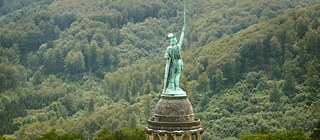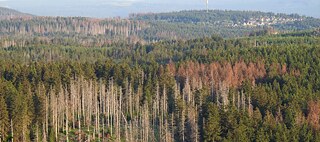The Forest in the Romantic Age
Soulful soughing

Germans feel a deep affinity for the forest that was uniquely expressed in the art of the Romantic Age. Now though, this place of dreams and yearning has become a poorly patient with a long and troubling medical history.
By Christa Sigg
We often only realise how deeply meaningful a relationship is when it is over, or at least in danger of disappearing. Then fear begins to spread. As in the mid-1980s, when the news was suddenly full of stories on acid rain and its terrible impact on the health of trees. This culminated in the first forest damage report in 1984, which reverberated through the nation like a shock wave. The idea that Germany might soon lose its forests sounded like the end of the world at the very least. And while “le Waldsterben”, neighbouring France adopted the German word with a hint of subtle irony, affected large swaths of Europe, it was seen as a doomsday scenario in the Federal Republic of Germany in particular.
So when and why did the Germans become so attached to the forest, a love celebrated in the most beautiful songs? Other European countries have forests too, after all. It likely goes back to the battle of the Teutoburg Forest 2000 years ago, victorious from a Germanic point of view and often stylized as an origin myth. In the telling, the large groups of trees seem to work as some sort of power elixir even a vastly superior army like that of the Romans was unable to conquer. This distracts from the fact that the legionnaires were lured into an ambush. This popular myth of a powerful German forest holding back enemies also seems a bit overdone, especially since it has been inflated by nationalists of all stripes.

Afforestation in art
The forest as a motif in art was not a completely new phenomenon; it had sprouted verdant green shoots throughout the various genres since late antiquity. Depictions range from the paradisiacal Tree of Knowledge and the Tree of Jesse to the tendrils and leaves carved on medieval capitals. Miniature painters such as the Limbourg brothers painted strikingly dense forests in the most famous 14th century Book of Hours, the Très Riches Heures of the Duke of Berry. And if the viewer is not distracted by the salvation taking place at the front of Jan van Eyck’s Ghent altar, a small forest appears behind the adored Lamb of God, along with hedges and a lot of hopeful greenery.
Somewhat later, around 1500, Albrecht Dürer kept a running record of the landscapes he passed through on his travels and basically argued that art was inherent in nature. You can spin this further – Dürer’s contemporaries from the Danube School, such as Albrecht Altdorfer, leveraged their skills to meticulously depict foliage, weather-beaten giant trees, and forests full of character, in a way anticipating the soulful landscapes of Caspar David Friedrich.
He is the best-known painter of the Romantic Age who took nature and the forest in particular as a central motif in the early 19th century. Friedrich immortalised gnarled oaks with unruly branches, lonely fir trees in the snow and forest landscapes at dusk on canvas. In each of these haunting images, the very trees themselves seem to stand for deeper truths, for states of mind, but also hint at transience and death. The Germans’ political impotence during the Napoleonic Wars and the Restoration gnawed at Frederich. In the same way, his subtly conceived paintings reveal a quiet celebration of the beauty and sublimity of nature with distinctly pantheistic echoes.
Artists like Ludwig Richter also transport the viewer into a harmlessly serene forest idyll where the civilisation-tormented soul can find rest. Humankind and nature come together in unity in work by Joseph Anton Koch. This idea also pervades the literature of writers like Joseph von Eichendorff, who transfigures the forest into a timeless ideal. “Out there, always betrayed, the busy world rushes. Draw your boughs around me once more, you canopy of green!” he wrote in his 1810 poem Abschied vom Wald (Farewell to the Forest) that Felix Mendelssohn-Bartholdy would set to music 30 years later.
There is truth in the forest, even if the fairy-tale collecting Brothers Grimm allow child-eating witches and grandmother-slaying wolves to lurk there. After all, the pinewood also provides protection from evil stepmothers and raging husbands. The concept of woodland solitude, coined in 1796 by Ludwig Tieck in Der Blonde Eckbert (Blonde Eckbert) runs like a common thread through Romantic poetry, and these at times ambivalent green retreats also play an important role in music.
A case for the intensive care unit
Shortly before 1850, Robert Schumann composed the Waldszenen (Forest Scenes), a series of nine piano pieces in a wide variety of moods from Jäger auf der Lauer (Hunter on the Lookout) to Einsame Blume (Lonely Flower). And 30 years later, the romantic topos of peaceful seclusion was still dominant in Waldweben (Forest Murmers) from Richard Wagner’s musical drama Siegfried, in which birdsong set the tone – until in his juvenile, uncouth vainglory, Siegfried awakened the dragon and misfortune took its course. The downfall came in the end, as the Rhine overflowed its banks and devoured the old world (of the gods).
Although the analogy is a bit of a stretch, climate change could have a similar effect. As if acid rain was not a grim enough chapter in the forest’s history, the situation has only gotten worse in subsequent years. “Our forests are sick,” was Federal Agriculture Minister Julia Klöckner’s bleak summary in the most recent 2020 National Forest Condition Survey. In real terms, this means that 79 percent of spruces, 80 percent of pines and oaks and a staggering 89 percent of beeches have been damaged. This process has been aggravated by a series of dry summers, making the trees easy prey for pests. The beleaguered forest has long needed a bed in the intensive care unit.
